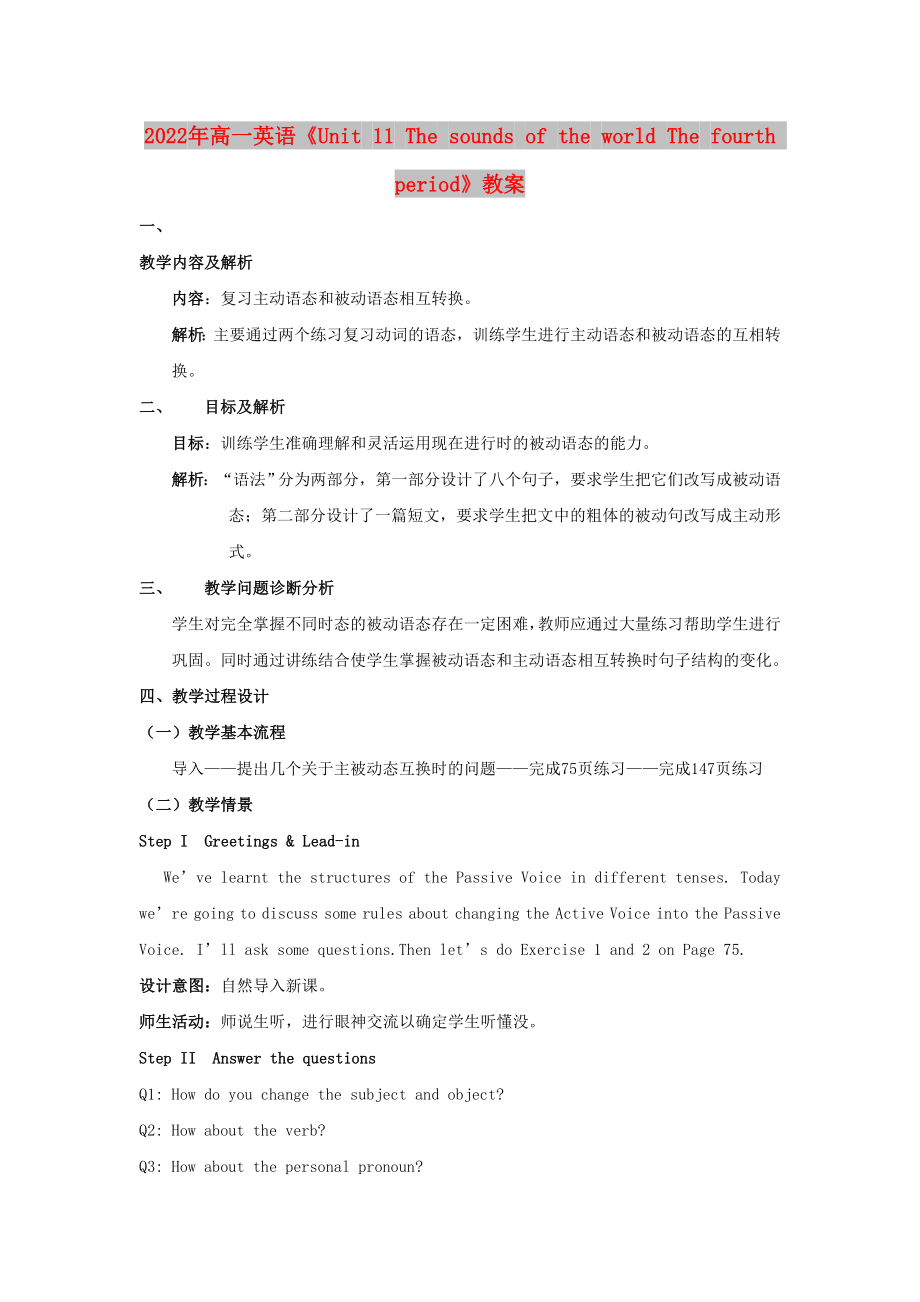《2022年高一英語(yǔ)《Unit 11 The sounds of the world The fourth period》教案》由會(huì)員分享���,可在線(xiàn)閱讀��,更多相關(guān)《2022年高一英語(yǔ)《Unit 11 The sounds of the world The fourth period》教案(3頁(yè)珍藏版)》請(qǐng)?jiān)谘b配圖網(wǎng)上搜索�����。
1��、2022年高一英語(yǔ)《Unit 11 The sounds of the world The fourth period》教案
一���、
教學(xué)內(nèi)容及解析
內(nèi)容:復(fù)習(xí)主動(dòng)語(yǔ)態(tài)和被動(dòng)語(yǔ)態(tài)相互轉(zhuǎn)換����。
解析:主要通過(guò)兩個(gè)練習(xí)復(fù)習(xí)動(dòng)詞的語(yǔ)態(tài)�,訓(xùn)練學(xué)生進(jìn)行主動(dòng)語(yǔ)態(tài)和被動(dòng)語(yǔ)態(tài)的互相轉(zhuǎn)換。
二���、 目標(biāo)及解析
目標(biāo):訓(xùn)練學(xué)生準(zhǔn)確理解和靈活運(yùn)用現(xiàn)在進(jìn)行時(shí)的被動(dòng)語(yǔ)態(tài)的能力����。
解析:“語(yǔ)法”分為兩部分��,第一部分設(shè)計(jì)了八個(gè)句子��,要求學(xué)生把它們改寫(xiě)成被動(dòng)語(yǔ)態(tài);第二部分設(shè)計(jì)了一篇短文����,要求學(xué)生把文中的粗體的被動(dòng)句改寫(xiě)成主動(dòng)形式。
三��、 教學(xué)問(wèn)題診斷分析
學(xué)生對(duì)完全掌握不同時(shí)態(tài)的被動(dòng)語(yǔ)態(tài)存在一定困難�,教師應(yīng)通過(guò)大
2、量練習(xí)幫助學(xué)生進(jìn)行鞏固��。同時(shí)通過(guò)講練結(jié)合使學(xué)生掌握被動(dòng)語(yǔ)態(tài)和主動(dòng)語(yǔ)態(tài)相互轉(zhuǎn)換時(shí)句子結(jié)構(gòu)的變化���。
四�����、教學(xué)過(guò)程設(shè)計(jì)
(一)教學(xué)基本流程
導(dǎo)入——提出幾個(gè)關(guān)于主被動(dòng)態(tài)互換時(shí)的問(wèn)題——完成75頁(yè)練習(xí)——完成147頁(yè)練習(xí)
(二)教學(xué)情景
Step I Greetings & Lead-in
We’ve learnt the structures of the Passive Voice in different tenses. Today we’re going to discuss some rules about changing the Active Voice into t
3�、he Passive Voice. I’ll ask some questions.Then let’s do Exercise 1 and 2 on Page 75.
設(shè)計(jì)意圖:自然導(dǎo)入新課��。
師生活動(dòng):師說(shuō)生聽(tīng)�,進(jìn)行眼神交流以確定學(xué)生聽(tīng)懂沒(méi)。
Step II Answer the questions
Q1: How do you change the subject and object?
Q2: How about the verb?
Q3: How about the personal pronoun?
Q4: How do you use by-phrase?
(
4����、After the discussion, teacher may ask some students to speak out their opinions and then make a conclusion)
Conclusion:
1. Use the object as the subject in the new sentences.
2. Change the verb “be” in the pattern “be + P.P.” in the new sentences.
Use the verb “be ” in pattern “be+ P.P.” in its
5、right form ( present or past, perfect or continuous, single or plural, etc.)
3. Change me into I when it used as the subject in the new sentences ( It is the same with him, her, us and them.)
4. Leave out the by-phrase in the new sentences, without change of the meaning.
設(shè)計(jì)意圖: 幫助學(xué)生理清主動(dòng)句與被動(dòng)句相互轉(zhuǎn)換時(shí)應(yīng)
6��、注意的成分變化.
師生活動(dòng):師提問(wèn)學(xué)生����,配合講解,適當(dāng)在黑板上體現(xiàn)所復(fù)習(xí)內(nèi)容���。
Step III Do the exercises on Page 75 Grammar.
設(shè)計(jì)意圖:對(duì)反復(fù)習(xí)內(nèi)容進(jìn)行當(dāng)堂鞏固加深��。
師生活動(dòng):讓學(xué)生先完成�,講學(xué)生給出答案����,教師對(duì)答案給予補(bǔ)充。
Step IV Do the exercises on Page 147 exercise 3.
設(shè)計(jì)意圖:對(duì)翻譯句子的能力進(jìn)行訓(xùn)練�����。
師生活動(dòng):生做師講��,可請(qǐng)學(xué)生回答��。
Step V 目標(biāo)檢測(cè)
單選題
1.He will stop showing off, if no notice _______
7����、_ of him.
A. is taken B. will be taken C. takes D. has taken
……
6. I want to buy that kind of cloth because I__________ the cloth ________ well.
A. have told; washes B. have been told; washes C. was told; washed D. have been told; is washed
設(shè)計(jì)意圖:對(duì)被動(dòng)句的用法進(jìn)行復(fù)習(xí)
8����、鞏固�。
師生活動(dòng):生做,師引導(dǎo)生核對(duì)答案��。
小結(jié):本節(jié)我們對(duì)前面所學(xué)的被動(dòng)語(yǔ)態(tài)進(jìn)行了全面的復(fù)習(xí)和鞏固�,學(xué)生們課后還可根據(jù)自己情況對(duì)無(wú)法熟練掌握的地方進(jìn)行查缺補(bǔ)漏,進(jìn)一步加深�����。
配餐作業(yè) 建議下列題中任選兩組題完成(AB)或(BC)
一�����、基礎(chǔ)題(A組題)
1.課本146頁(yè) Vocabulary 部分第一����、二題
設(shè)計(jì)意圖:進(jìn)一步掌握新單詞、詞組�。
二、鞏固題(B組題)
課本147頁(yè) Grammar 部分一、二題
設(shè)計(jì)意圖:鞏固所復(fù)習(xí)語(yǔ)法內(nèi)容��。
三��、提高題(C組題)
用被動(dòng)態(tài)翻譯下列句子
1.這些工廠都由政府經(jīng)營(yíng)�����。
……
6.這樣就使得我們省了很多麻煩�����。
設(shè)計(jì)意圖:提升學(xué)生翻譯能力�。
教學(xué)反思:
 2022年高一英語(yǔ)《Unit 11 The sounds of the world The fourth period》教案
2022年高一英語(yǔ)《Unit 11 The sounds of the world The fourth period》教案

